Page 427 of 474

426 Practical hints
Jump starting
If the battery is discharged, the engine can
be started with jumper cables and the bat-
tery of another vehicle. Observe the follow-
ing:
�Jump starting should only be performed
when the engine and catalytic convert-
er are cold.
�Do not start the engine if the battery is
frozen. Let the battery thaw out first.
�Only jump start from batteries with the
same voltage rating (12 V). Jump start-
ing with a higher voltage battery could
damage the vehicle’s electrical system,
which will not be covered by the
Mercedes-Benz Limited Warranty.
�Only use jumper cables with sufficient
cross-section and insulated terminal
clamps.
�Always make sure the jumper cables
are not on or near pulleys, fans, or
other parts that move when an engine
is started or running.
Warning!G
Failure to follow these directions will cause
damage to the electronic components, and
can lead to a battery explosion and severe
injury or death.
Never lean over batteries while connecting
or jump starting, as you could otherwise be
injured.
Battery fluid contains sulfuric acid. Do not
allow this fluid to come in contact with eyes,
skin or clothing. In case it does, immediately
flush affected area with water, and seek
medical help if necessary.
A battery will also produce hydrogen gas,
which is flammable and very explosive. Keep
flames or sparks away from battery, avoid
improper connection of jumper cables,
smoking, etc.
Attempting to jump start a frozen battery
can result in it exploding, causing personal
injury.
Read all instructions before proceeding.
!Vehicles with automatic transmission*:
Do not tow-start vehicle.
!Avoid repeated and lengthy starting
attempts.
Do not attempt to start the engine using a
battery quick charge unit.
If the engine does not run after several
unsuccessful starting attempts, have it checked
at the nearest authorized Mercedes-Benz
Center.
Excessive unburned fuel generated by repeated
failed starting attempts may damage the
catalytic converter and may present a fire risk.
Make sure the jumper cables do not have loose
or missing insulation.
Make sure the cable clamps do not touch any
other metal part while the other end is still at-
tached to a battery.
Page 428 of 474
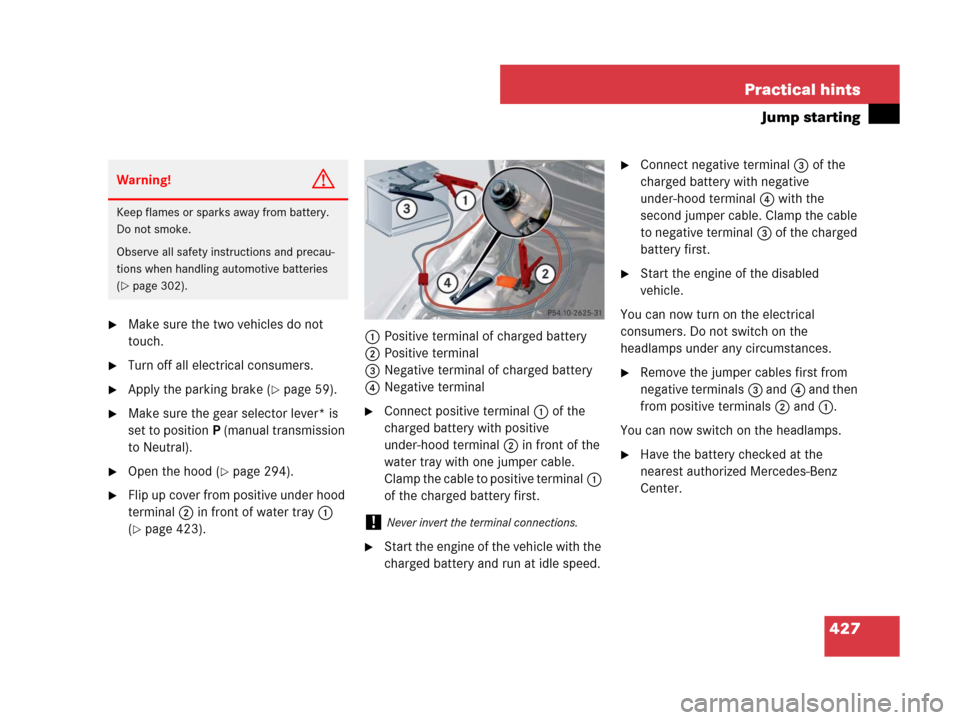
427 Practical hints
Jump starting
�Make sure the two vehicles do not
touch.
�Turn off all electrical consumers.
�Apply the parking brake (�page 59).
�Make sure the gear selector lever* is
set to positionP (manual transmission
to Neutral).
�Open the hood (�page 294).
�Flip up cover from positive under hood
terminal2 in front of water tray1
(
�page 423).1Positive terminal of charged battery
2Positive terminal
3Negative terminal of charged battery
4Negative terminal
�Connect positive terminal1 of the
charged battery with positive
under-hood terminal2 in front of the
water tray with one jumper cable.
Clamp the cable to positive terminal1
of the charged battery first.
�Start the engine of the vehicle with the
charged battery and run at idle speed.
�Connect negative terminal3 of the
charged battery with negative
under-hood terminal4 with the
second jumper cable. Clamp the cable
to negative terminal3 of the charged
battery first.
�Start the engine of the disabled
vehicle.
You can now turn on the electrical
consumers. Do not switch on the
headlamps under any circumstances.
�Remove the jumper cables first from
negative terminals3 and4 and then
from positive terminals2 and1.
You can now switch on the headlamps.
�Have the battery checked at the
nearest authorized Mercedes-Benz
Center.
Warning!G
Keep flames or sparks away from battery.
Do not smoke.
Observe all safety instructions and precau-
tions when handling automotive batteries
(
�page 302).
!Never invert the terminal connections.
Page 429 of 474
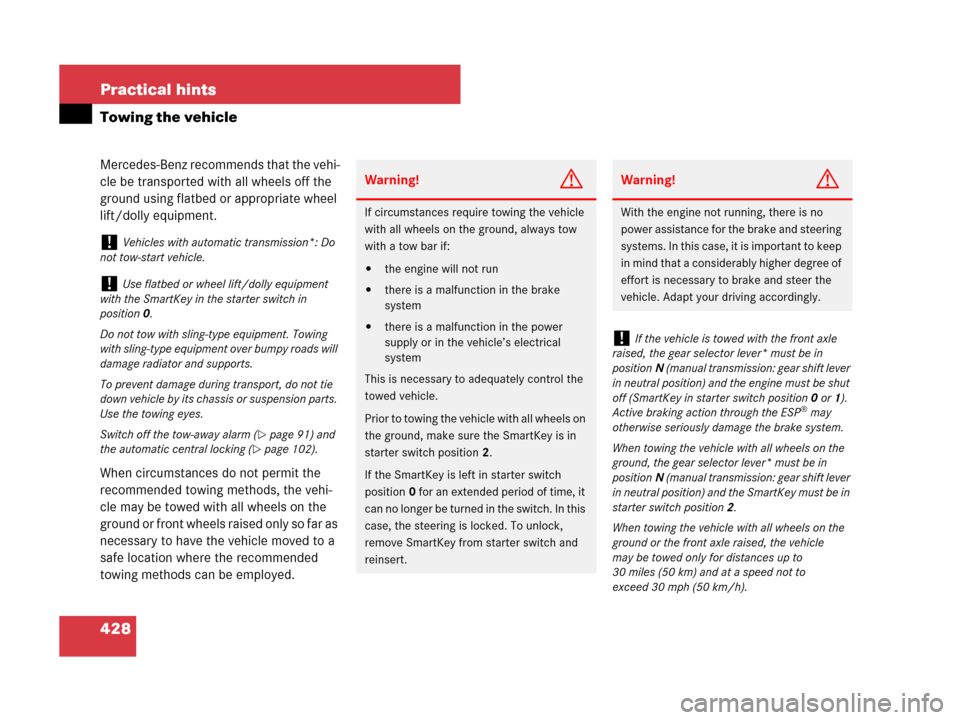
428 Practical hints
Towing the vehicle
Mercedes-Benz recommends that the vehi-
cle be transported with all wheels off the
ground using flatbed or appropriate wheel
lift/dolly equipment.
When circumstances do not permit the
recommended towing methods, the vehi-
cle may be towed with all wheels on the
ground or front wheels raised only so far as
necessary to have the vehicle moved to a
safe location where the recommended
towing methods can be employed.
!Vehicles with automatic transmission*: Do
not tow-start vehicle.
!Use flatbed or wheel lift/dolly equipment
with the SmartKey in the starter switch in
position0.
Do not tow with sling-type equipment. Towing
with sling-type equipment over bumpy roads will
damage radiator and supports.
To prevent damage during transport, do not tie
down vehicle by its chassis or suspension parts.
Use the towing eyes.
Switch off the tow-away alarm (
�page 91) and
the automatic central locking (
�page 102).
Warning!G
If circumstances require towing the vehicle
with all wheels on the ground, always tow
with a tow bar if:
�the engine will not run
�there is a malfunction in the brake
system
�there is a malfunction in the power
supply or in the vehicle’s electrical
system
This is necessary to adequately control the
towed vehicle.
Prior to towing the vehicle with all wheels on
the ground, make sure the SmartKey is in
starter switch position2.
If the SmartKey is left in starter switch
position0 for an extended period of time, it
can no longer be turned in the switch. In this
case, the steering is locked. To unlock,
remove SmartKey from starter switch and
reinsert.
Warning!G
With the engine not running, there is no
power assistance for the brake and steering
systems. In this case, it is important to keep
in mind that a considerably higher degree of
effort is necessary to brake and steer the
vehicle. Adapt your driving accordingly.
!If the vehicle is towed with the front axle
raised, the gear selector lever* must be in
positionN (manual transmission: gear shift lever
in neutral position) and the engine must be shut
off (SmartKey in starter switch position0or1).
Active braking action through the ESP
® may
otherwise seriously damage the brake system.
When towing the vehicle with all wheels on the
ground, the gear selector lever* must be in
positionN (manual transmission: gear shift lever
in neutral position) and the SmartKey must be in
starter switch position2.
When towing the vehicle with all wheels on the
ground or the front axle raised, the vehicle
may be towed only for distances up to
30 miles (50 km) and at a speed not to
exceed 30 mph (50 km/h).
Page 433 of 474
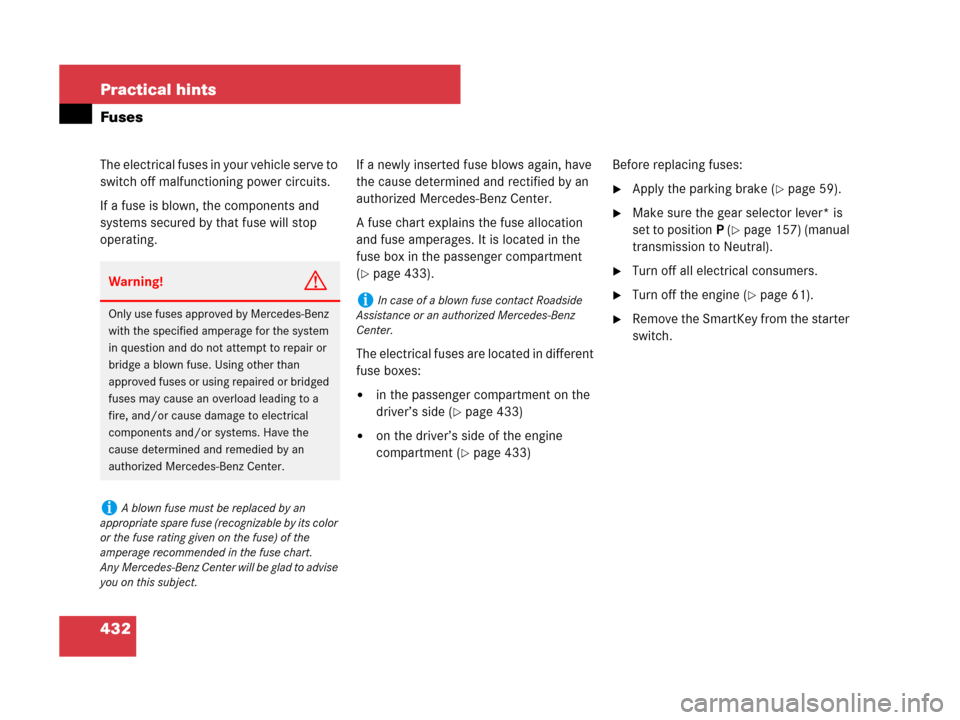
432 Practical hints
Fuses
The electrical fuses in your vehicle serve to
switch off malfunctioning power circuits.
If a fuse is blown, the components and
systems secured by that fuse will stop
operating.If a newly inserted fuse blows again, have
the cause determined and rectified by an
authorized Mercedes-Benz Center.
A fuse chart explains the fuse allocation
and fuse amperages. It is located in the
fuse box in the passenger compartment
(
�page 433).
The electrical fuses are located in different
fuse boxes:
�in the passenger compartment on the
driver’s side (
�page 433)
�on the driver’s side of the engine
compartment (
�page 433)Before replacing fuses:
�Apply the parking brake (�page 59).
�Make sure the gear selector lever* is
set to positionP (
�page 157) (manual
transmission to Neutral).
�Turn off all electrical consumers.
�Turn off the engine (�page 61).
�Remove the SmartKey from the starter
switch.
Warning!G
Only use fuses approved by Mercedes-Benz
with the specified amperage for the system
in question and do not attempt to repair or
bridge a blown fuse. Using other than
approved fuses or using repaired or bridged
fuses may cause an overload leading to a
fire, and/or cause damage to electrical
components and/or systems. Have the
cause determined and remedied by an
authorized Mercedes-Benz Center.
iA blown fuse must be replaced by an
appropriate spare fuse (recognizable by its color
or the fuse rating given on the fuse) of the
amperage recommended in the fuse chart.
Any Mercedes-Benz Center will be glad to advise
you on this subject.
iIn case of a blown fuse contact Roadside
Assistance or an authorized Mercedes-Benz
Center.
Page 434 of 474
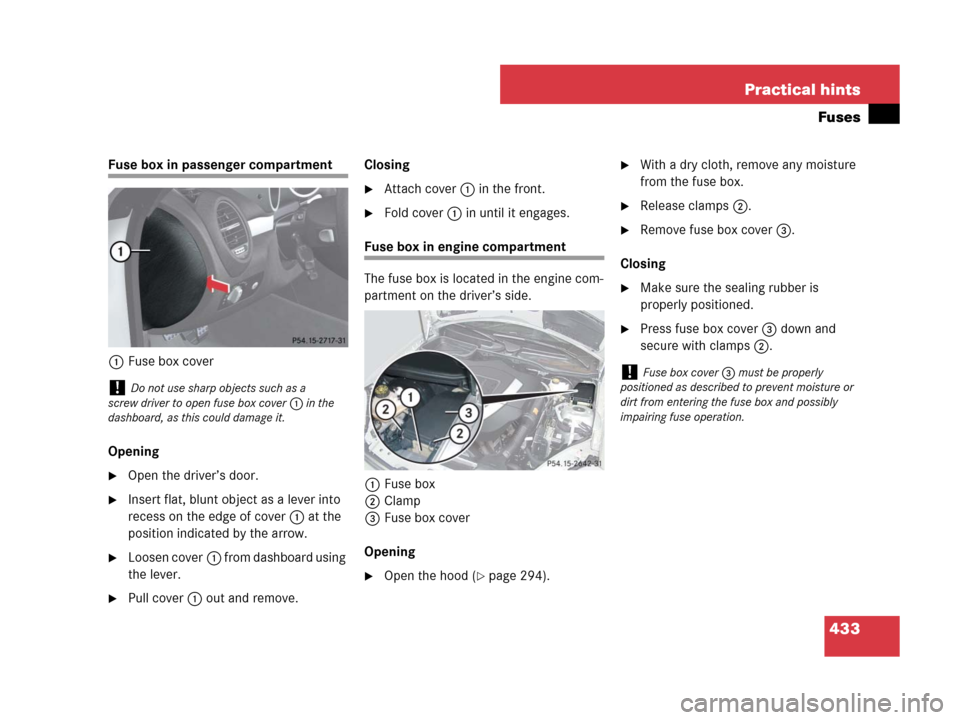
433 Practical hints
Fuses
Fuse box in passenger compartment
1Fuse box cover
Opening
�Open the driver’s door.
�Insert flat, blunt object as a lever into
recess on the edge of cover1 at the
position indicated by the arrow.
�Loosen cover1 from dashboard using
the lever.
�Pull cover1 out and remove.Closing
�Attach cover1 in the front.
�Fold cover1 in until it engages.
Fuse box in engine compartment
The fuse box is located in the engine com-
partment on the driver’s side.
1Fuse box
2Clamp
3Fuse box cover
Opening
�Open the hood (�page 294).
�With a dry cloth, remove any moisture
from the fuse box.
�Release clamps2.
�Remove fuse box cover3.
Closing
�Make sure the sealing rubber is
properly positioned.
�Press fuse box cover3 down and
secure with clamps2.
!Do not use sharp objects such as a
screw driver to open fuse box cover1 in the
dashboard, as this could damage it.
!Fuse box cover3 must be properly
positioned as described to prevent moisture or
dirt from entering the fuse box and possibly
impairing fuse operation.
Page 436 of 474
435 Technical data
Parts service
Warranty coverage
Identification labels
Layout of poly-V-belt drive
Engine
Rims and tires
Electrical system
Main Dimensions
Weights
Fuels, coolants, lubricants, etc.
Page 440 of 474
439 Technical data
Identification labels
4VIN 5Engine number (engraved on engine)
6VIN (lower edge of windshield)
7Emission control information label,
includes both federal and California
certification exhaust emission
standards
iWhen ordering parts, please specify vehicle
identification and engine numbers.
Page 442 of 474
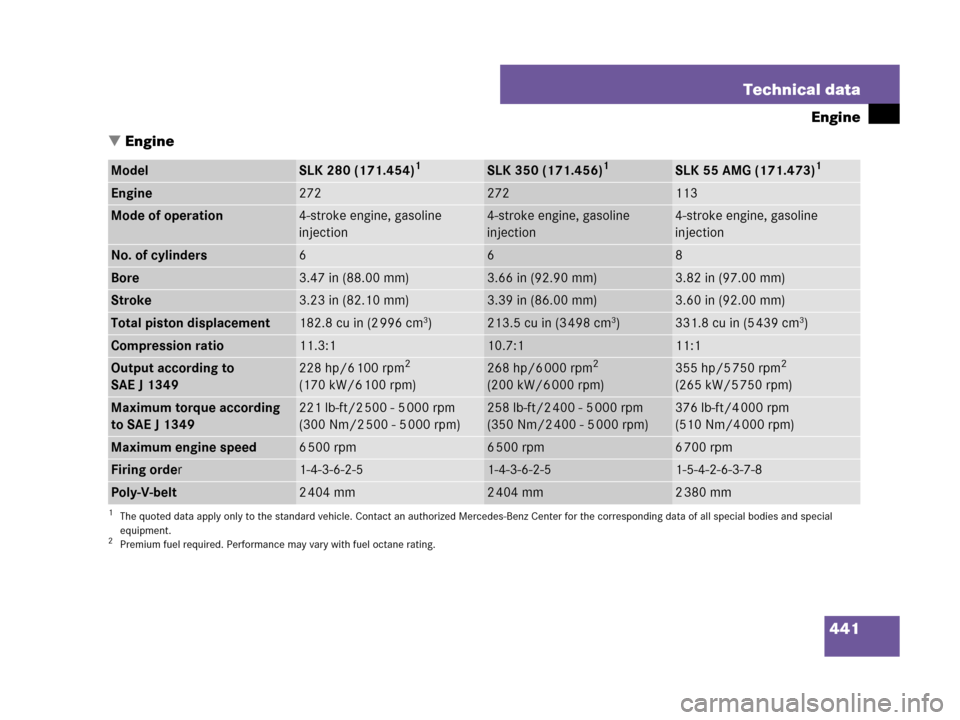
441 Technical data
Engine
�Engine
ModelSLK 280 (171.454)1
1The quoted data apply only to the standard vehicle. Contact an authorized Mercedes-Benz Center for the corresponding data of all special bodies and special
equipment.
SLK 350 (171.456)1SLK 55 AMG (171.473)1
Engine272272113
Mode of operation4-stroke engine, gasoline
injection4-stroke engine, gasoline
injection4-stroke engine, gasoline
injection
No. of cylinders668
Bore3.47 in (88.00 mm)3.66 in (92.90 mm)3.82 in (97.00 mm)
Stroke3.23 in (82.10 mm)3.39 in (86.00 mm)3.60 in (92.00 mm)
Total piston displacement182.8 cu in (2 996 cm3)213.5 cu in (3 498 cm3)331.8 cu in (5 439 cm3)
Compression ratio11.3:110.7:111:1
Output according to
SAE J 1349228 hp/6 100 rpm2
(170 kW/6 100 rpm)
268 hp/6 000 rpm2
(200 kW/6 000 rpm)
2Premium fuel required. Performance may vary with fuel octane rating.
355 hp/5 750 rpm2
(265 kW/5 750 rpm)
Maximum torque according
to SAE J 1349221 lb-ft/2 500 - 5 000 rpm
(300 Nm/2 500 - 5 000 rpm)258 lb-ft/2 400 - 5 000 rpm
(350 Nm/2 400 - 5 000 rpm)376 lb-ft/4 000 rpm
(510 Nm/4 000 rpm)
Maximum engine speed6500 rpm6500 rpm6700 rpm
Firing order1-4-3-6-2-51-4-3-6-2-51-5-4-2-6-3-7-8
Poly-V-belt2404 mm2404 mm2380 mm